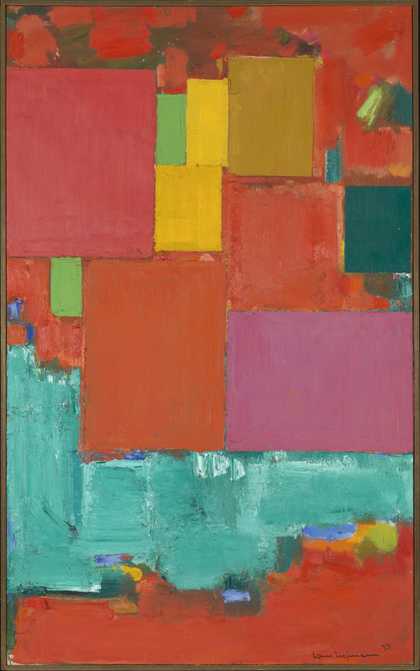
Fig.1
Hans Hofmann
Pompeii 1959
Oil paint on canvas
Support: 2140 x 1327 mm
Tate T03256
© The estate of Hans Hofmann
What are Hans Hofmann’s legacies – his meaning, or meanings, for subsequent artists, historians and critics? If the answer is unclear today, it was perhaps even more so in Hofmann’s lifetime. By the time of the artist’s death in 1966, there were wildly divergent assessments. For critic Sheldon Cheney, Hofmann was an expressionist seeking out the essences of objects.1 For artist Allan Kaprow, the spatial dynamics of Hofmann’s paintings were a prompt for the expanded social field of happenings: the ‘push’ and ‘pull’ of shapes on a canvas could become the literal pushing and pulling of furniture around a room.2 Yet perhaps the greatest sense of Hofmann’s appeal to different interpretations is evidenced by his critical place in the art histories written in the 1950s and 1960s by two antagonists: Clement Greenberg, for whom Hofmann exemplified ‘American-type painting’ and its complicated relationship to European modernism, and Harold Rosenberg, who saw Hofmann as an exemplar of action painting. This section examines the competing interpretations offered by Greenberg and Rosenberg in order to enrich our understanding of both Pompeii 1959 (Tate T03256; fig.1) and its viewers. Just as Pompeii takes on a new complexity when we multiply our critical lenses – when its floating slabs become markers of empathy, action or physical movement – so, too, do neglected and misconstrued ideas gain new depth when explicated through the concrete specifics of a single painting. Pompeii offers a training ground for several ideas about self, society and art in the United States at mid-century.
Greenberg on Hofmann: Colour and cubism
Hofmann was a formative influence on Greenberg. As the critic himself later explained, Hofmann ‘in his classes and in a series of public lectures held in 1938–9, reminded us that there was more to high painting than Cubist design. (For myself, just beginning to be able to see abstract art, these lectures were a crucial experience.)’3 As Caroline Jones notes in her intellectual biography of Greenberg, ‘The aspiring critic’s heroes, saints and devils had largely been literary, political, and philosophical until Hofmann’.4 Hofmann’s painting and teaching provided a launch pad into visual art for Greenberg, just as he was formulating his ideas about high and mass culture in seminal essays like ‘Avant-Garde and Kitsch’ (1939) and ‘Towards a Newer Laocoon’ (1940).
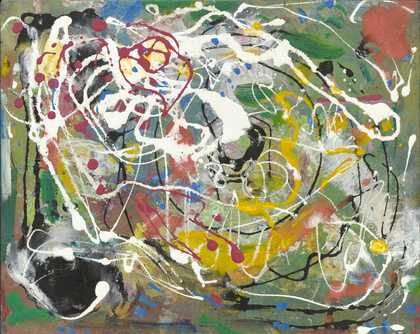
Fig.2
Hans Hofmann
Spring 1944–5
Museum of Modern Art, New York
© 2017 Estate of Hans Hofmann/Artists Rights Society (ARS), New York
Over the next twenty-five years Hofmann would serve, in Greenberg’s writings, as both prophet and warning. Greenberg gave him a prime place within abstract expressionism: ‘Over the past fifteen years’, he wrote in 1955, ‘a body of painting has emerged in this country that deserves to be called major. Hans Hofmann’s art and teaching have been one of its main fountainheads of style’.5 As fountainhead, Hofmann’s art was prophetic, employing techniques (drips, dark areas of colour crowded together) well in advance of their common use – see, for instance, Hofmann’s Spring 1944–5 (fig.2). Such paintings were, Greenberg wrote in 1959, ‘more important as art than as prophecy, but it is only in the light of what they did prophesy that people like myself have learned to appreciate them; ten years ago and more, when they were first shown, they were too new’.6 Yet at the same time Greenberg remained ambivalent about just how to accommodate Hofmann’s art – and especially its variety – into a canon of abstract expressionism. Even as he praised the painter, he noted ‘the distractedness of his art in its abstract phase’,7 the ‘lack of self-evident coherence in the development of his art’,8 and the ‘inconsistency’ of his oeuvre.9 Hofmann’s lack of ‘coherence’ was puzzling to many, but it posed a particular problem for a critic like Greenberg, who was preoccupied with art’s linear progression. As Jones writes, the problem was how to ‘rescue’ Hofmann from his ‘dynamic oscillations’ and thus allow ‘an evolutionary scheme to function’.10
What was it about Hofmann’s art that resonated with Greenberg? In his writing the critic returns regularly to two main topics: colour and cubism. From his first texts on the artist, Greenberg admired (but also struggled with) the ‘intensity of color’ in his paintings.11 Colour was Hofmann’s true lesson for subsequent painters: ‘you could learn more about colour’, Greenberg wrote in 1957, ‘as long as it was only a question of learning, from Hofmann than from Picasso, Miro or Klee’.12 Hofmann accomplished this, according to Greenberg, through an unconventional approach to both colour value and temperature. ‘By tradition, convention, and habit’, Greenberg explained in his famous essay ‘American-Type Painting’ (1955), ‘we expect pictorial structure to be presented in contrasts of dark and light, or value. Hofmann, who started from Matisse, the Fauves, and Kandinsky as much as from Picasso’, rejected value contrast as the essential building block.13 Such ‘elisions of light-and-dark contrast’ are evident in Pompeii: when reproduced in black and white, much of the surface becomes the same grey colour, with only two strong spots of contrast: the cadmium yellow bars at the painting’s centre line and the dark green slab at the right. Moreover, Hofmann makes his palette decidedly hotter: in Pompeii, reds, magentas and yellows predominate. Greenberg notes how the ‘uniform warmth and brightness’ of Hofmann’s ‘high, shrill colors’ offer few, if any, areas of relief.14 Even his cooler pigments, like blue, ‘will be infused with unaccustomed heat’.15 The result is dissonance: ‘Because blue and green … are inherently cool colors,’ Greenberg writes, ‘a discord is created when they are used in warm shades as a foil to inherently warm colors like red and orange; instead of giving the eye the cool relief it expects from them, they tax it further by sustaining the warmth – much the way unresolved chords tax the ear’.16
Throughout Greenberg’s statements on Hofmann’s use of colour, one can detect an anxiety about taste and thus, indirectly, about class. The painter’s ‘jarring color contrasts’ are ‘dissonant’, but this is a sign, Greenberg reassures us, of the art’s ‘difficulty’, not ‘its bad taste’.17 Furthermore, he states, ‘With time … one’s eyes become attuned’ to the discordant notes.18 This applies not only to Hofmann’s colour but also to his gesturalism and the ‘open, pulsating surface’ of his canvases. As Greenberg writes in a remarkable passage,
most of the genuinely original painting of the last century and a half has struck standard good taste, on first sight, as being too raw in facture; time alone has done the smoothing and refining. Hofmann’s art is a microcosm of the process, for as his thickly painted pictures dry out, and their colors come close together in key, they become smoother, firmer in their unity, more traditional in their resonance, and their force becomes more compatible with elegance.19
Even as he appreciates the dissonance in Hofmann’s art, Greenberg contemplates its future elegance, as its jarring colours begin to harmonise and a sense of unity accrues to its wayward brushstrokes. It is as though Greenberg is visualising the (usually invisible) process by which modernism – here, a colouristic version uncomfortably close to mass culture – ascends the ladder to good taste, becoming, in the critic’s famous phrasing, ‘formal culture with its infinity of aspects, its luxuriance, its large comprehension’.20 ‘Looked at longer’, Greenberg assures us, Hofmann’s ‘sprightliness gives way to calm and to a noble and impassive intensity’.21
Greenberg’s other main concern with Hofmann was the question of cubism, and to what degree the painter had or had not ‘digested’ its lessons.22 Often, Greenberg saw Hofmann replacing cubist or geometric logic with colour itself, forging ‘a fully chromatic art’ that somehow supplied its own structure.23 Yet at other times he accused Hofmann of reverting too literally to the cubist grid: Hofmann ‘will too often impose Cubist drawing upon pictorial conceptions that are already complete in themselves’24 or indulge in a ‘quasi-geometric truing and fairing of lines and edges’.25 The slab paintings played an interesting role here because they arrived on the scene relatively late, after the critic had done the bulk of his writing on the artist. In his 1961 book on Hofmann, Greenberg presents the slab paintings as another surprising turn:
[A]s I was putting the present text together, the coherence of one important theme of his recent development emerged with sudden and unforeseen clarity. In this theme, Hofmann’s cubism, while becoming more outspoken than ever before in oil, began at the same time to vindicate and transcend itself – as if purposely to refute what I already said about it.26

Fig.3
Hans Hofmann
Cathedral 1959
Museum of Modern Art, New York
© 2017 Estate of Hans Hofmann/Artists Rights Society (ARS), New York
He goes on to trace the development of the slab paintings from their beginnings in 1954 (‘little knifed-on oblongs of thicker pigment that resemble mosaic pieces’) to more recent works like Cathedral 1959 (fig.3), in which the oblongs ‘suddenly swell out into large square, or nearly square, slabs of equally uniform color’.27 Like Pompeii, Cathedral combines ‘a purely geometrical art’ with ‘a freely brushed and variegated ground’. Once again, Greenberg takes pains to extract something elegant, even static, from this dynamic blend of structure and gesture. Describing Cathedral’s parallels with the work of Dutch modernist Piet Mondrian, its inheritance from cubism and its ‘unexpected complexity of color relations’, Greenberg asserts that ‘The outcome, like the outcome in every profoundly successful picture, is a stability that is sovereign because it is hard-won and precarious’.28 Slab paintings like Pompeii may be precarious, seductive and jarring, but Greenberg simultaneously endows them with a poised, even regal, stability.
Rosenberg on Hofmann: Coherent variety
Like Greenberg, art critic Harold Rosenberg attended Hofmann’s lectures on abstract art in 1938–9. A poet and public intellectual, Rosenberg began writing on the visual arts for the leftist journal Art Front in the mid-1930s. Yet for much of that decade and the following one, Rosenberg was primarily known as a cultural and literary critic. Through his training in law and his early writings on drama, Rosenberg developed a particular interest in the concepts of the act, the actor and the stage, tropes he used to analyse everything from legal identity to William Shakespeare’s play Hamlet (1599–1602) to Marxist history. In the 1930s he took a job with the Works Progress Administration’s Federal Art Project, which brought him into closer contact with many New York artists and, eventually, led him to Hofmann’s lectures.
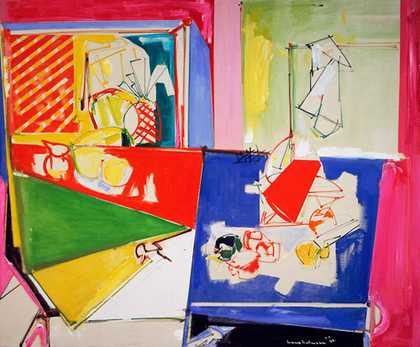
Fig.4
Hans Hofmann
Magenta and Blue 1950
Whitney Museum of American Art, New York
© The estate of Hans Hofmann
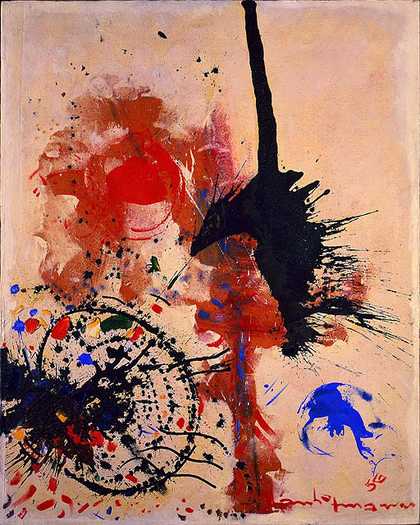
Fig.5
Hans Hofmann
The Prey 1956
University of California, Berkeley Art Museum and Pacific Film Archive, Berkeley
© The estate of Hans Hofmann
As in Greenberg’s accounts, Rosenberg’s writings on Hofmann emphasised the painter’s multiple styles – what he calls Hofmann’s ‘coherent variety’.29 Yet such variety constituted less of a problem for Rosenberg, whose model of modernism was based on rupture rather than evolution. Furthermore, Rosenberg’s conception of identity, informed by the stage identities put on by actors and the legal identity of ‘guilty’ or ‘innocent’ applied in court, easily accommodated shifts in character or guise. ‘I distinguish in Hofmann’s work three (or four) major phases’, he stated in a 1957 profile of the artist, ‘though Hofmann does not close off these phases from one another but goes back and forth among them’.30 These three phases, detailed in the profile and expanded upon in a later essay, are the ‘study of “Nature”’ (Hofmann’s landscapes and still lifes, in various degrees of abstraction), automatism and action painting.31 In his ‘automatism’ phase, according to Rosenberg, Hofmann would begin with a subject in nature but, ‘once his notations have begun working on each other the canvas is allowed to take over’, and he ‘follows the intimations of the picture’s brain with its dialectic of tensions and counter-tensions’.32 Rosenberg groups very different paintings together in this phase, from the splatters and blotches of The Prey 1956 (fig.4) to ‘constructions rigged of geometrical contours’ such as Magenta and Blue 1950 (fig.5) and Perpetuita 1951 (Renate, Hans and Maria Hofmann Trust, New York). Where Greenberg sees the vestiges of cubism – geometry, structure – Rosenberg sees a dialogue between painter and canvas, in which the geometrical ‘rigging’ is the result of a meandering, questing line, a sort of call-and-response between artist and painting. Rosenberg frequently recasts the visual as the dialogic or even the interpersonal, investing formal elements with relational, social meanings.
In Hofmann’s action painting phase, the works ‘dispense with the representation of the [emotional or pictorial] state in favor of enacting it in physical movement’.33 Rosenberg coined the term ‘action painting’ in 1952, largely looking to Willem de Kooning as his model.34 But in the ensuing years he expanded its parameters to cover a range of abstract expressionist painters, including Hofmann, Arshile Gorky and even (although with some reservations) Jackson Pollock.35 In works like Hofmann’s Burst into Life 1952 (private collection) and Liebesbaum 1954 (R. and H. Batliner Art Foundation, Vaduz), a ‘linear momentum’ akin to ‘figure skating’ unspools across the canvas, with ‘each such line … establish[ing] the actual movement of the artist’s body as an esthetic statement’.36 In contrast to works by other action painters, Rosenberg notes, Hofmann’s ‘are distinguished by the immense variety of the motions that compose them; the traces of his actions range in force and physical density from mere wisps of tint to draggings and pilings of cementlike masses of pigment’.37 Such ‘traces’ carry with them not just the evidence of physical movement, but a range of psychological, spatial and chance resonances. ‘In turning to action’, Rosenberg explains, ‘abstract art abandons its alliance with architecture … and offers its hand to pantomime and dance’, arts that rely on shifting and unpredictable relationships between actors, environments and viewers.38 Somewhat paradoxically, the action painting must freeze these aleatory relationships, fossil-like, in the matrix of paint; but it is able, at its best, to provoke echoes of these physical and psychological states in the viewer. ‘With regard to the tensions it is capable of setting up in our bodies’, Rosenberg writes, art ‘is an extension of the physical world; a stroke of pigment “works” within us in the same way as a bridge across the Hudson … an accidental blot or splash of paint may … assume an equivalence to the profoundest happening’.39
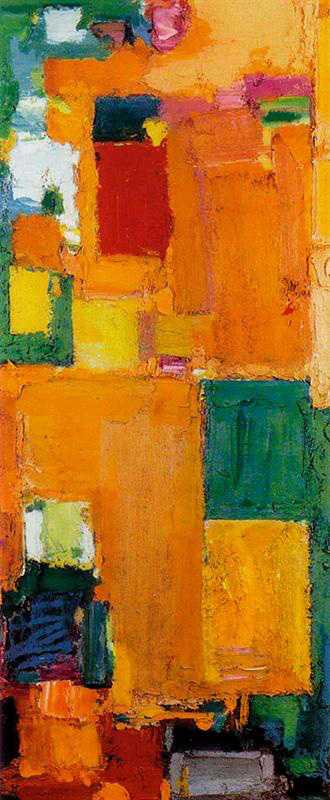
Fig.6
Hans Hofmann
Kaleidos 1958
Private collection
© The estate of Hans Hofmann
When Rosenberg encountered the slab paintings at the end of the 1950s, he assigned them to Hofmann’s action painting phase. This may seem surprising, given the conventional idea of action painting as redolent of movement and speed. Rosenberg himself implied as much, noting how Hofmann sometimes employed the slabs – ‘smoothly brushed rectangles of pure colour’ – as ‘counterpoint[s]’ to the ‘shocks and vibrations’ of the canvases or as ‘balances within [the] shaken-up depths’.40 Yet he also accepts as action paintings those slab works entirely ‘conceived on a structural hypothesis’, which emphasise ‘equilibriums of colour and size in the simplest of mathematical shapes’.41 Works such as Combinable Wall I and II 1961 (University of California, Berkeley Art Museum and Pacific Film Archive, Berkeley) and Kaleidos 1958 (fig.6) ‘demonstrate that action in painting need not be dependent upon violent brushwork’ but can be effected through formal means, such as ‘the backward-and-forward movement produced by relations of hue and scale’.42 Pompeii, in setting up a rhyming movement within the viewer, and in its combination of painterly handling and geometric slabs, thus makes manifest the dynamic at the heart of action painting: a dialogue between the automatic and the intentional, the premeditated and the spontaneous. ‘The great Hofmanns’, Rosenberg writes, ‘are those composed of acts protracted in the vibrant centre between theory and the unexpected’.43
Turning to Hofmann, Greenberg and Rosenberg each managed to find an exemplary, if at times confounding, expression of modern American art as each was constructing it. The two critics were famous antagonists, a conflict memorialised in Greenberg’s 1962 essay ‘How Art Writing Earns Its Bad Name’.44 In part, their antagonism was the product of two competitive egos operating in the same, fairly small, milieu. But it was also the result of fundamental differences in outlook mapped onto nearly identical social and personal conditions: both were Jewish intellectuals in New York; neither began their professional careers as art critics; and both would eventually turn to the visual arts as a form of salvation and a way of making sense of modernity. They pursued their self-education in art along very different paths. Greenberg subjected himself to a ruthless education of the eye that would render modernism a question of, in his famous phrasing, ‘eyesight alone’, while Rosenberg relied on his knowledge of artists’ techniques and working methods to make paintings into metaphors for self and agency in the twentieth century. For one, Pompeii might thus have represented the painter’s belated ‘digestion’ of European modernism, while for the other the work’s floating rectangles could have stood as markers of human action. It is a measure of the painting’s richness and complexity that it could provoke and sustain multiple, often divergent, readings.
